The Courtney Memorial Hall, Aspley Guise
By the side of the Square in Aspley Guise stands a small single-storey chapel building, until recently used as an Evangelical Free Church. It bears a plaque to the front wall announcing that it is the “Courtney Memorial Hall”.
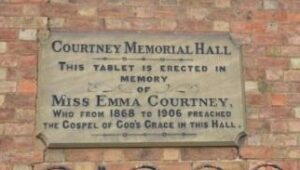
The building did not start out as a chapel. It was once the home of the Aspley Guise British School. It was probably established before 1842 in a disused barn in the Square, but this was taken down in 1842 and the building you see today built to better accommodate it (there is a date stone on the gable end of the Hall). This building belonged to a local Quaker, Richard Thomas How, but passed on his death in 1835 to his nephew William, who in turn left it to his widow Lucy in 1862. Thus either William or Lucy How were responsible for establishing the school. The first known teacher was John Wood, who was noted as schoolmaster in a directory of 1850 and was still there a year later when the census was taken. This school continued until 1879, when the British School was merged with the National School under the 1870 Education Act. As the National School premises in Woburn Lane were much larger, that building was carried forward as the village Board school and this one became a Mission Hall.
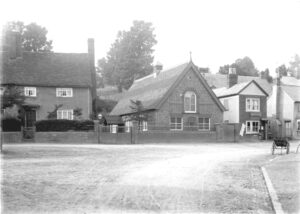
The 1871 census of Aspley Guise shows a household on Salford Road headed by Miss Emma Courtney. She was 51 years of age and gave her birthplace as London. Listed as a Boarder in the house was Miss Agnes Laws, 30, born in Great Yarmouth. There was also a visitor, Emma Fountaine, 10 and one servant Jane Litchfield, 14, from Newport Pagnell.
Emma Courtney and Agnes Laws had met in London in 1859, where Emma’s father was a merchant in the West End (a China Dealer?) Agnes was the daughter of a ship broker and agent. Both had a passionate zeal for working with the people in “the most hopeless of London’s slums” and had decided that the root cause of such poverty was the demon drink. They had exhausted themselves in such labours and came to Aspley Guise in 1867 for a rest, but had decided to stay and help the poor here too.
According to the Leighton Buzzard Observer, 2nd December 1879, a lecture was given at “the Mission Room (late British School)” by Rev. D. P. Alford on the subject of Aryans and the first chapter of European history. In 1881 comes the first mention of Miss Courtney preaching at the hall, but it was obviously not her first event there. The Leighton Buzzard Observer says she spoke there on a Sunday evening in January, “in persuance of her usual custom”. Her Annual Report of for the Hall in 1908 was labelled as the 41st such, giving a commencement of activities in 1867, the year they had arrived.
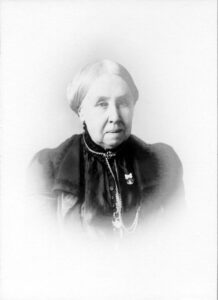
The 1881 census gives Emma Courtney, of “Independent means”, listing her birthplace as St. George, Hanover Square, London. Agnes A. Laws was still a Boarder, also of “Independent Means”. Elizabeth Pigott had become their servant, aged 48. The Mission Room had a renovation in Autumn 1882, but no specific details on the work were given in the corresponding newspaper report:
“ASPLEY GUISE. Mission Room. This room has recently been very much improved at considerable expense, the greater part being paid by Mrs. How. The alterations done by the committee amounted to £7, and to raise a part of this amount a social tea meeting was held Tuesday last, to which all friends and total abstainers were invited, and goodly number accepted the invitation. In the evening a lecture was delivered by Miss Laws, when a large company assembled. Miss Courtney presided, and briefly introduced Miss Laws, who for upwards of an hour spoke the evils of intemperance, and urged upon those present to abstain. The lecture was an exceedingly good one, being delivered in a manner that riveted the attention of the audience. Before Miss Laws finished her lecture, Miss Higgins sang very nicely a solo “That little bit of blue,” the company joining in the chorus. Miss Laws then asked those present who were abstainers to wear the blue ribbon and at the close thirty persons did so and a few signed the pledge. It will be interesting to those connected with the Mission Room to learn that the collection taken after the tea amounted to £5 1s. 3d. The committee of the Total Abstinence Society have granted £1 from its funds, so that only 18s. 9d. is now required to clear the amount expended.” (Leighton Buzzard Observer – 7th November 1882)
The owner of the building, Lucy How, died in 1889 and left the building to her nephew, Frederick Corder. He immediately sold it to Henry Paul Harris and the conveyance refers to the building as “the Mission Room, formerly used as a British School”. [BARS: CRT130Asp19].
There followed hundreds of events over the next 25 years, overseen by the ladies. Mostly, these were in support of the anti-alcohol Temperance movement, trying to get men and women to “take the pledge” not to consume alcohol in any form. There were Band of Hope events. Church of England Temperance Society (CETS) meetings, the British Women’s Temperance Association (BWTA) and the Total Abstinence Society, all holding fund-raising concerts, sacred cantatas and visiting evangelistic missionaries. The Hall was again renovated in the summer of 1890:
“ASPLEY GUISE. Mission Room. ln connection with the re-opening of the Mission Roam, which has been undergoing thorough repair and is greatly improved, a tea was given to raise funds towards purchasing a new American Organ, on Thursday, July 24th, at 5 o’clock in a field kindly lent by D. Ellis. Twelve trays were provided by friends and about 100 sat down to tea. £4 15s. was received. On Sunday Jonathan Grubb, of Ludbury, Suffolk, an old and much esteemed friend, conducted morning and evening service to large and attentive congregations. Miss Laws presided at the new organ, and the collections amounted to £4 13s. 6d. Previously to these meetings the Mission Room Committee had contributed £10 10s., and friends attending the services £10 I11s., collection at Band of Hope treat 7s. 9d. The Bible Society have kindly given a grant of Bibles.” (Beds Mercury – 2nd August 1890)
The 1891 census records Emma Courtney described as “Living on Own Means”, but gave her birthplace as Old Bond Street, London. Agnes Laws was described, very unusually, under Relationship as a “Friend”, also “Living on Own Means”. The same servant as the last census was still with them, Elizabeth Piggott, now 58.
Both ladies had bad cases of influenza in January 1894, which prevented them from running the normal Sunday services for a fortnight. Mr. Herbert Studman of Woburn stepped in to take charge. The same week saw the publication of the Annual Report of the Aspley Guise Mission Room and Total Abstinence Society committee. The Mission Room had taken £69 5s. 3½d., with expenses of £69 5s 5d; the “String Band & Instrument Classes” took in £23 17s 5¾d, with expenses of £23 14s. 11d. and the Total Abstinence Society takings were £14 14s. 11½d. with expenses of £14 8s. 8½d. In October that year, a Young People’s Society of Christian Endeavour branch was formed after a meeting held in the Mission Room.
The Hall was also used as a base for travelling missions, who toured the country in wagons, preaching wherever they camped. In August and October 1895, Mr. Tom Horrocks, known as the “Converted Clown” stayed for 11 days, hosting temperance meetings and preaching twice a day. A Mrs. Green celebrated her 50 years of abstinence in October 1895 with a “Teetotallers Jubilee” at the mission room. Then 80 years of age, her milestone was recognised by a tea for 100 members and friends of the Aspley Guise Total Abstainer’s Society, who presented the lady with a new armchair. The Aspley Guise Band were in attendance to provide suitable music. The 1898 income report showed a small loss. From the Luton Times, 28th January:
“ASPLEY GUISE. Mission Room. The balance sheet in connection with this room shows the total amount collected during the year to be £119 1s. 1½ d., and the following amounts have been divided amongst the different branches of the work as follows: Mission Room £41 8s. 8½d. Total Abstinence Society £11 19s. 3½d., Band of Hope £26 15a. 4½d and string band £26 19s. 1½d., while £2 was collected for the Temperance Hospital by Miss Robinson, and 19s. 5½d. realised as a result of a temperance sermon for the Band of Hope Union. The expenditure amounted to £3 18s. 1d. above the income.”
In the late 1890’s, the Mission Room Band seems to have been quite popular. They were able to save up enough for an annual trip to the seaside. Another large refurbishment took place in the summer of 1899, when the Hall was closed for three weeks while works were completed. The principle change was the raising of the ceiling by five feet and match-boarding, this work being done by local builder, Mr. Charles Sinfield.
The 1901 census gives Emma Courtney, now 81, who had reverted back to St. George, Hanover Square as her birthplace, with Agnes Agnew Laws as a Boarder. Elizabeth Pigott was still their “Cook Domestic”, now 69 years old herself, so they had also taken on Rose Robinson, 18, from Aspley Guise, as a “Housemaid Domestic”.
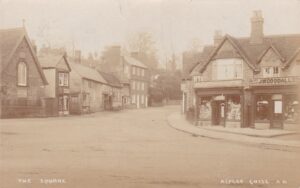
Emma Courtney continued preaching at the hall until just eight days before she died, in December 1906, which was two days after her 87th birthday. This obituary appeared in the Bedfordshire Mercury on Friday 21st December:
“THE LATE MISS COURTNEY. It was with unfeigned regret we heard last week, just as we were going press, that the venerable Miss Courtney, of “Grasmere,” Aspley Guise, had passed away on December 13, at the patriarchal age of 87, her birthday being on the Tuesday prior to the Thursday on which she died. Miss Courtney was a fine type of the cultivated intellectual English woman, gifted with a strong mind in a vigorous body, and possessed of an ardent religious temperament, kept within due restraint by a well-balanced mind and a wide charity. Doubtless most of her friends would speak of Miss Courtney in terms of the revivalist; we prefer to describe her in unconventional terms, as an ardent Evangelical Christian; she united the dignity of the Church of England, in which she was brought up, with the fervour of an earnest Methodist, but she associated herself with no organized Church on leaving her early associations behind her. She was akin to the Friends in her opinions concerning outward rites and ceremonies, and believed in personal consecration as the only proof of the truly religious life. After her first awakening to the reality of sacred things she resolved to do what she could to carry her message to the poor and the outcast. At that time she was living in London, her father being a prosperous merchant in the West End; and she threw herself into Mission work with all her eager nature. The results not only astonished her, but bore witness to her zeal and earnestness.
More than half century ago, just before the Crimean War, if we mistake not, she met a devoted young girl, name Agnes Agnew Laws, and between these two, separated though they were by many years in age, sprang up friendship which developed into the closest and more than sisterly intimacy, and this has never ended. After working together in London, with marvellous success, and often among the most hopeless of London’s slums, they became in great need of rest and change. They resolved to take rooms at Aspley Guise, near the pinewoods, for a year’s retirement, hearing that it was really a health resort, though not widely known such. Miss Courtney was entitled to rest; she was nearing fifty years of age, and could afford to live ease and enjoy the latter half of her life in peace. The two ladies went to the Parish Church, and took part in the usual devotions in that old edifice. But, as they moved through the pretty village, in the Summer evenings, they noticed, especially on Sundays, that the villagers had no opportunity of improvement, no congenial and friendly place of call – except the public house. Sunday evening service at church was then unknown. In a most modest way they invited a few of the poorer men to meet at their house for Bible reading and prayer – and that eventuated in their obtaining use of the British School-room for Sunday classes – for men only.
But the village women found their needs not then met; they rejoiced that their homes were becoming happier because their husbands were being weaned from baser Sunday pleasures and excesses, and they waited outside the School-room door – at first in vain. At length, one eager woman listening outside had her heart touched as never before; she heard a message of good tidings, which turned her life towards God and goodness, and, in her rejoicing, she ran and called her neighbours, and they almost stormed the little hall, until the good ladies were convinced that a Divine Hand was thus using them. The barrier of sex was broken, and the message was given to all and any who cared to hear it. That is nearly forty years ago, and from then till now the work has never ceased. The British School was converted into a regular Mission Room, and there with unaffected modesty Miss Courtney has been the voluntary pastor of the little flock, and Miss Laws has been her right-hand supporter in every good work. They did not limit their work to merely technically religious gatherings, but fostered every effort to promote Thrift and Temperance among all classes. They were enabled to rescue many who were on the slippery paths of self-indulgence, and thus the Mission Room became an active centre of Temperance effort, both for adults and juveniles. When the younger men and women left Aspley for the greater world beyond, Miss Courtney always kept up her interest in their careers, and every year wrote hundreds of letters to every quarter of the globe.
When she lay dying, vessels were conveying her last Christmas messages to former adherents in Australasia and elsewhere. She was at the Mission Room on Sunday, November 18, and preached her last public sermon there. In her eight days’ illness, her mind was quite clear to the end; and, though rapid pneumonia supervened, and her frame was at times much distressed, her lifework was supreme in her thoughts, and she preached at least three distinct sermons completely, ending each with her usual benediction. Through the week’s illness she was devotedly nursed by Miss Laws, both day and night, and Dr. Brandon was in frequent attendance, being hopeful to the end that his venerable patient might conquer the attack. Everything was ready for continued life or speedy death, and the last bequests were made. Soon, however, the last prayers were said, and then, on Thursday morning, holding Miss Laws the hand, as though loth to leave her life-long devoted friend, the gentle soul bade farewell to earth without murmur, and with scarce a sigh.
When the news spread in the parish it was felt that everybody had lost a friend, and the deepest sympathy was manifested for Miss Laws in her almost overwhelming sorrow. Letters, telegrams, messages, came in from all parts – several hundreds altogether – and then came flowers, for Miss Courtney loved flowers, and everything else that was beautiful.
On Tuesday afternoon the whole village drew down its blinds, from the Rectory to the humblest cottager, and many tears were shed as silent body of the good woman was reverently conveyed to the Mission Room for the last time. The whole parish was practically in mourning, and the genuineness of the grief was only too apparent. The flowers overflowed the coffin, and filled another vehicle as well. The Mission Room was crowded, and Miss Edith Binfield played “Oh, Rest in the Lord” very tenderly as the sorrowing friends entered the little place; the reading desk bore no black, for formalities were naught to the dear departed, but in front it was a large white ribbon, in bow, symbol of cheerful hope as well as the British Women, who were mourning their beloved President. After prayer by Mr R. H. Poynter, Mr Braggins read the first portion of the Burial Service, including the usual lesson from I. Corinthians xv. He also read another passage of comfort from an earlier chapter, and then spoke reverently of the departed, of the work she had done, and of the sympathy all felt for her bereaved friend. “Peace, perfect peace,” was sung during this service. The interment took place in the parochial cemetery, where a brick grave had been lined with evergreens and chrysanthemums. The committal portion of the service was undertaken by Mr Rowland Hill, of Bedford, an old friend of the Mission Hall workers; and in unconventional language, he briefly alluded to the saintly character of Miss Courtney, to their confidence in her having already entered the blest Paradise of God, and to the sweet thought that there was no real death; for the porch way we called death but led into the nearer presence of the Loving Father of Mankind. A prayer of thanksgiving, and for help, for courage, and for endurance to the end, followed the Lord’s Prayer; and then Miss Laws touched everybody’s heart as she spoke of her own sorrow and of her dear friend’s final wishes and prayers. Two verses of “For ever with the Lord” were sung, and Mr Braggins pronounced the usual benediction. It was now near the sunset hour, but the large assembly lingered long over the newly-hallowed spot, till the darkness and the heavy mist compelled the last of many mourners to depart. Among those from Bedford who attended were Mrs Edwin Ransom, Miss Sturges, and Miss E. Lucas (representing the British Women), and from Leicester came two Misses Ellis, old friends of the Mission Room. All the villages near were represented, and the noble character of the deceased lady was the theme of conversation in the whole neighbourhood. Our readers will glad to know that Miss Laws will still reside at “Grasmere,” and that she will carry on the work as far she possibly can according to the wishes of her lamented companion and leader., Mr Sinfield had charge of the funeral arrangements, and carried them out in harmony with the wishes of Miss Courtney…”
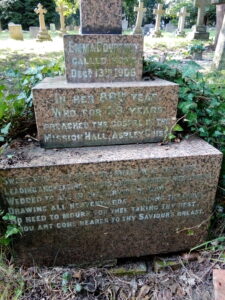
There followed a long list of mourners and floral tributes. When worshippers left after the next weeks’ service at the Hall, they were handed portrait photographs of Miss Courtney and Miss Laws. It was to Miss Laws that Miss Courney left all her Will, which totalled £26,567 13s. 9d., quite a sum for the time.
Miss Laws seems to then have emerged from the shadow of Miss Courtney and swiftly arranged for the purchase of the Hall from the current owner. Henry Paul Harris, a merchant of Whitechapel, London (who bought the Hall in 1889) had died by 1905 and it had then passed to Stanley Harris of Aspley Guise, J.P. Having been unsuccessful in securing the hall in the past, Miss Laws finally convinced him to sell it and she paid £525 [BARS: CRT130Asp19] Within two weeks, she had transferred it into the hands of six Trustees by a Deed of Gift, to be used for religious and social purposes. The first Trustees were:
R. H. Poynter, of Bedford,
Herbert Studman, of Woburn,
Charles Sinfield,
Horace Steers,
Richard Sedgwick and
W. H. Smith, the solicitor of Woburn.
She also bestowed it with a large endowment to “come into force at the close of Miss Law’s life” to carry on the good work. It specified that evangelical doctrines would be taught there and if they ever decided to sell the Hall, the money so raised should be used by the Trustees to build alms-houses for the aged poor. (Beds Times – 5th July 1907) She also arranged to rename the Hall.
Two days of events were held to mark the red-letter day of changing the name of the Mission Hall to the Courtney Memorial Hall. Mr Dawe, an evangelist of London first preached to a large congregation. Mrs. Ormiston Chant spoke at a public meeting chaired by Miss Laws. Hymns were sung with Miss Edith Sinfield at the harmonium and lessons were read and although no Bishop or priest was present the whole celebration was treated as a new consecration. There was a column and a half filled with a report on the religious zeal and anti-alcohol rhetoric in the Beds Mercury. As well as renaming the mission hall and unveiling the plaque (which reads: “COURTNEY MEMORIAL HALL. This Tablet is erected to the memory of the late Miss Emma Courtney, who from 1868 to 1906 Preached the Gospel of God’s Grace in this Hall.”) there was also an idea put forward to add a memorial fountain to the trough in the middle of the Square so humans could slake their thirst too, but this would take nearly four years to accomplish.
From the Bedfordshire Mercury – 4th February 1910:
“Courtney Hall. Miss Laws, in the New Year’s address just issued, gives a thoroughly interesting reference to good work carried on in London by Miss Courtney and herself from 1859 (when they first met) until they came to Aspley in 1867, also of their united efforts here. Miss Laws trusts that she may be enabled to continue the Memorial Hall services till their re-union, when it is left in trust for as long a period as the work shall benefit the village, failing which, the trust deed arranges for the building and endowment to utilized in erecting Courtney Memorial Almshouses for aged poor, irrespective of sex or creed. From statements of accounts, signed by Misses Laws, E. Sinfield and C. Crisp, also Messrs Kemp, Turvey, Singfield, F. W. Last and A. E. Lemmey, the total sums raised during 1909 amounted to £136 16s. 6½d., thus:- Memorial Hall, £46 14s. 8d.; Total Abstinence Society, £4 13s. 5d.; Band of Hope, £22 11s.; B.W.T.A., £9 0s. 5½d.: String Band, £15 4s. 4d.; Dr. Barnardo’s sale, £36 4s. 10d.; Temperance Sunday, £1; Thames Court Mission, 12s.; Temperance Hospital, 15s. 9½d.”
The 1911 census was to be the last she appeared on. Still living at “Grasmere”, she had taken on more help and also had a male visitor in the house: Agnes Agnew Laws, 71, of Private Means; Elizabeth Piggott, Housekeeper, 79, House Keeper; Rose Robinson, Servant, 28, Cook Domestic; Elizabeth Harriet Moss, Servant, 27, House Maid Domestic and Harold Wilts Ryde, Visitor, 38, Insurance Clerk.
In the spring of 1911, plans for the memorial water trough and fountain were submitted to the Parish Council. May After some discussion of where the where water would come from, it was agreed. From the Beds Times, 9th June 1911:
“OPENING OF THE MEMORIAL FOUNTAIN. The occasion of the opening of the Water and Sewerage Works on Thursday was deemed a fitting one for the opening, by the Duchess of Bedford, of the Drinking Fountain in the Square. Aspley Guise, dedicated to the memory the late Miss Courtney, who did so much beneficent work in religious and social missions in London and Aspley Guise. The fountain, which was supplied by the Drinking Fountain and Cattle Trough Association was erected by the endeavours of the local Band of Hope, the R.S.P.C.A. and Miss Laws, an intimate friend of Miss Courtney. The fountain is built of handsome grey granite, and bears the following inscription: “Erected in loving memory of the late Miss Courtney by members of the Band Hope, R.S.P.C.A., and other friends, 1906.”
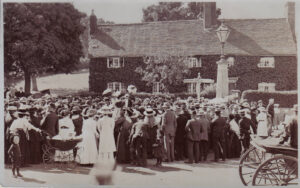
The Square presented a bright and animated appearance as the Duke and Duchess of Bedford and the Joint Committee of the Water and Sewerage Scheme arrived from the Abbey. Among the local residents present were Miss Fitzroy, Mr. D. White, Mr. W. J. Mordaunt, Mr. J. Mordannt, Mr. C. Sinfield (who built the fountain). Miss Westoby (local secretary of the R.S.P.C.A.), Miss Laws, Miss Payne, the Rev. J. C. Maltby, Mr. C. P. Hall, the Rev. J. Palmer, the Rev. D. W. [?] the Rev. Mr. Foyster, Mr. Elliott, Mr. Chetham. Mr. Stonebridge. R.S.P.C.A. Inspectors Roberts (Bedford), Goodyer (Aylesbury), and Philpot (Luton).
Miss Laws related the story of Miss Courtney’s connection with Aspley Guise which she came 44½ years ago, and how the memorial fountain had originated. It gratified her exceedingly that the Duchess of Bedford should have consented to open it.
Her Grace then turned on the water and declared the fountain open, and the Duke of Bedford said that a long time ago he went to one of Miss Courtney’s services, and he was very glad to be in Aspley again and open the memorial to her.
Miss Laws proposed, and Mr. G. E. Brown seconded a vote thanks to the Duchess, and cheers for the Duke and Duchess concluded the ceremony.”
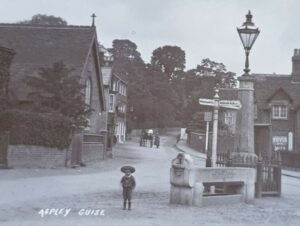
In July, the fountain was handed over to Aspley Guise Parish Council to run. That summer, Mr. A. McFadyen was appointed as an assistant to Miss Laws. She eventually passed away 13 years later. From the Beds Times, 28th May 1920:
“The memorial service for the late Miss Agnes Agnew Laws was conducted at the Courtney Memorial Hall on Saturday, by Mr. Alex MacFadyen, assisted by Mr. R. H. Poynter, who had been associated with deceased’s temperance work for a long period. The gathering was large and representative, those present including the employees of “Grassmere,” and a number of private friends, Mr. W. H. Smith, Mr. O. Minter, Mr. Wingrave. Mr. John Turney. Mr. H. Boon, the Rev. S. Coleman (Rector), Mr. U. Mordaunt, Mr. H. sheers. Mr. O. Negus, the Infirmary Matron from Ampthill, and Mr. C. J. Minter. Mr. G. E. Brown, Chairman of the District Council, was unable to be present, but representatives from that body were Messrs. A. MacIntire, Kent. A. W. Pettit and A. Norris, with the Revs. R. F. Scott and H. A. Beresford. The service, simple but very impressive, included the singing of “For all the Saints” and “Peace, perfect Peace.” At the graveside, Mr. Rowland Hill, of Bedford, said the committal sentences and afterwards gave an address. On Sunday further memorial services were held at the Hall. Mr. MacFadyen conducting the presence of large congregations. The wreaths included one from the British Women Society and from the Women’s Liberal Association.”
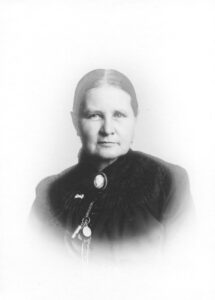
Her details were added to the granite edging on either side of the Cross bearing Emma Courtney’s details in Aspley Guise churchyard, with “In Life, In Death, Not Divided“. Miss Laws left £21383 0s. 4d. to her solicitor, W. H. Smith of Woburn, to carry out her requests regarding funding the Hall. Their long-time servant, Elizabeth Piggott, lived until 1926 and died at Grasmere Cottage too, aged 94, having lived there 45 years.
Pastor MacFadyen published a devotional book whilst at Aspley Guise in 1920, called “Vignettes of Victory. – Sermon Seed in the Psalms”. (“Price; Paper Covers, 2/6, bound in Cloth, gold lettered, 4/6.”) He had departed by 1923, as a Pastor Phillips was in charge when the accounts were issued for 1923. They showed receipts of £117 11s. 11d. (including weekly offerings of £55 12s. 3d. Expenses were £111 12s. 10d.
In 1924, Pastor C. W. Davis arrived and took over. He seems to have been very popular and well-respected in the village. Every year on the anniversary of his arrival, a celebration was held. In 1929, he hosted the fifth annual industrial exhibition and flower show in the Hall, which therefore must have started the year he arrived. It was in aid of the Courtney Memorial Hall Star Band, of which Davis himself was President. As well as prizes for best flowers, cakes and needlework, good attendance was also rewarded. The Kempston Bunyan Choir were on hand to entertain guests. The money raised went towards an outing for the Star Band. (Beds Times – 21st June 1929)
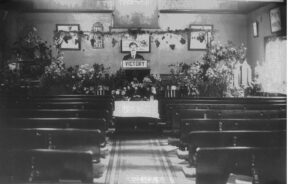
There were special celebrations when Pastor Davis reached 21 years of service in God’s work in 1933. Mr. Robert Lee, superintendent of the Manchester City Mission, came to give a service. The Rev. Archibald Macfadyen, who had previously been in charge of the hall for 11 years returned for a visit in 1938. He was now a Baptist minister in Edinburgh. He gave a lantern lecture of scenes (more than 100 of them!) which included some of Aspley Guise prior to the First World War.
Just two days after the Second World War started, the hall had a new organ installed:
“Aspley Guise. NEW ORGAN. On Sunday afternoon a pipe organ recently purchased from Elstow Church, was dedicated for service in the Courtney Memorial Hall. Pastor Davis officiated during the day assisted at the special service by the Rev. J. Cornish, of Shefford, and Elstow Church organist.” (Leighton Buzzard Observer – 5th September 1939)
By this time, the internal addition of a wooden club room must have been built at the rear of the hall, as Pastor Davis was using it by October the same year as a base for some of the children evacuated to Aspley Guise from bomb-threatened London. After the war, new ration books were distributed from the same Club Room.
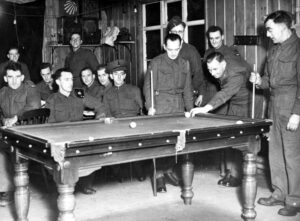
Here, the detailed coverage in the indexed newspapers currently available online dries-up. At some point, the local Trustees transferred the Hall to the The Fellowship of Independent Evangelical Churches, removing the clause that any sale proceeds should be used for local Almshouses. The chapel continued to be used as an Evangelical Free Church until approximately 2016, when it finally closed-up for good. It stood empty for some years before the FIEC decided to sell and use the money raised to support other Churches they manage. It was put up for sale by auction with Cheffins of Cambridge on 16th September 2020, with an estimate of £220,000+.
They described it as:
“Former Chapel in village location. Total plot of approximately 0.11 acres. Change of use/development potential subject to Planning. Freehold with vacant possession. A rare opportunity to purchase a former Chapel in the heart of the popular and desirable village of Aspley Guise. The Chapel was originally constructed in 1842 as a school, and features traditional brick walls beneath a decorative pitched tiled roof. Inside the property, the Chapel features the following accommodation: Main hall area (6.45m x 12.3m) with triple aspect windows and vaulted panelled ceiling; Office Room (3.06m x 2.91m) with part panelled walls and window; Ancillary Room/Lobby (3.39m x 3.08m); Kitchen with a single base unit, butler-style sink and doors to front and rear; Cloakroom with WC and sink. The property has a gross internal floor area of approximately 106m (excluding outhouses). The Chapel has not been in regular use for a number of years and requires basic repairs for its existing use or more extensive works as part of a conversion project, making it an ideal investment/development opportunity subject to Planning. Outside: To the rear are 2 outhouse stores which are in poor condition. The property is not listed but lies within the village conservation area. There is off-road car parking and a garden area to the rear of the building. The total plot is approximately 0.11 acres. It is considered that there may be some scope for change of use/conversion and it is recommended that interested parties make inquiries of the local planning authority in this regard. The outbuildings are connected to another property.”
The Hall sold for £295,000.
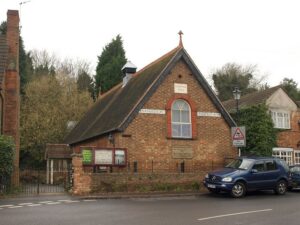
Page last updated Sept 2020.
